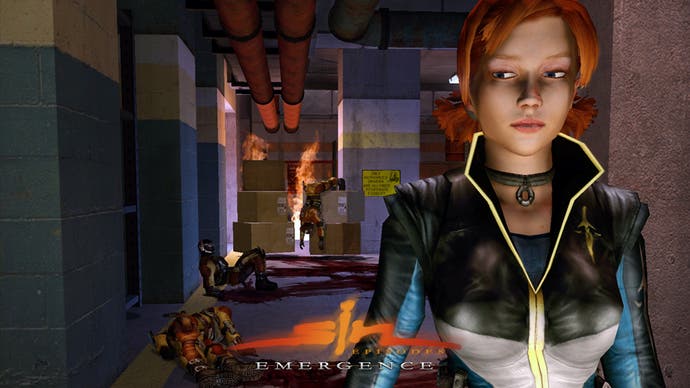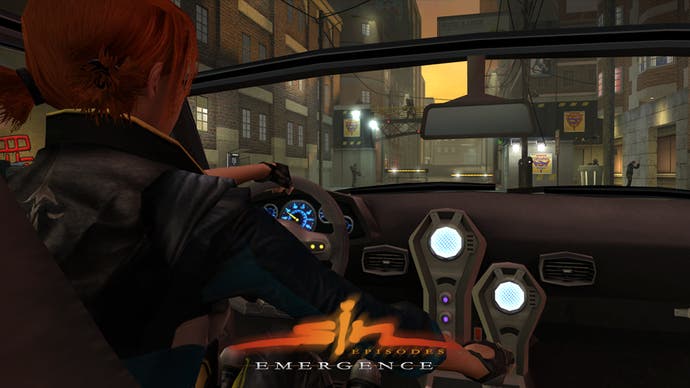Sin Episodes: Emergence
Sin waves. Divisive.
You know when Sin came out at the same time as Half-Life and everyone thought, "man, I bet they're gutted"? I'm not convinced they were. Sin Episodes: Emergence, the first in a new line of five-hour first-person shooters set in the Sin universe, is so firmly stuck in 1998 that I'm not even sure they've played Half-Life now. They really should.
It's the sort of first-person shooter nobody makes any more. You wake up on an operating table staring at the evil, cackling Elexis' stupid cleavage, then escape thanks to rookie-Jessica. There's a touch of Half-Life 2 to the duck-and-jump chase sequence at the docks before you get a gun, but like the rest of the modern bits it's a nod rather than an actual shift. It's all about combat, and the combat's only about a couple of things - headshotting people with the pistol, from virtually any distance, or running away from the sound of a chaingun spinning up.
Bizarre, then, that it's actually pretty enjoyable. This being an episode rather than a full game, there are only a trio of guns and a handful of enemy types, and the handful of hours you all spend together quickly assemble themselves into an engaging formula. Most of the grunts can be killed with one headshot, and the pistol's very accurate, so most of the first-half encounters are straightforward. If they come toward you, they die. So, laughably, their best strategy is to move sideways, wandering along a gangway up above or strafing before they open fire. Then it's about readjusting the sights on both ends. Keeping an eye on that Half-Life damage indicator. There's no notion of enemy teamwork or taking cover; they're moths to the muzzle flare.

The middle enemies, the mutants, are easily dispatched with a mousewheel flick to the shotgun. Their little headcrab-style friends are a nuisance but little more. The tougher enemies are the armour-plated chaingunners, which require at least a secondary-fire grenade-launch and a few rounds from the machinegun before you tag their explosive backpacks. With the difficulty spiralling out of control in the latter half of the game, you learn to flee from the telling audio cue. And you come to groan whenever you hear it the seventh or eighth time in a row, in the same room, which you do. Oh so much. Then, whenever Jessica joins you - usually as a means to spur the action on somehow - it's in indestructible-dimwit form, drawing enemy fire. Ultimately, Emergence is about waiting for people to stop side-stepping and using a girl as a decoy for huge men with guns. A far cry from Half-Life 2's improvised disc-gun and, well, Far Cry's sprawling openness.
What little the game does that's new is a side-show. Grunts and mutants can kick barrels and chairs at you, boxes fall over, there's the desperately occasional minor physics puzzle and the level of environmental interactivity and detail is up there with the other Source Engine games. Green barrels hold something called mutagen gas that engulfs you in bullet time, and it's largely pointless. Meanwhile the level design, with its endless knotted corridors in warehouses, docks, a tanker and a tower - all uniformly full of crates and locked doors to bounce off - doesn't gain much from the generational shift apart from a fairly nice glass-breaking effect. The bosses are about circle-strafing and firing as many bullets as possible before you run out of health; that was old when Sin was the norm. Shooting exploding barrels, which take a hit to ignite and then roll around and explode a second later, is deliciously Half-Life, but it's the FPS equivalent of being given a rattle to play with between spankings.
The one innovation, if you can call it that, is the way the health dispensers work. Like Half-Life, each is a med-station on a wall with a finite amount of health available. Unlike Half-Life, the health packs that they run off can be ripped out and replaced by others found nearby - perhaps in a desk-drawer or one of the myriad lockers sprinkled around. (Man - lockers, eh? Where have they been?) On the surface, it's a neat trick. You not only have to remember where the last health station is; you have to find health for it. Except, it's not neat, because carrying a health canister involves pressing 'e' to magically suspend it in front of you where it can get caught on doorframes and shelving units as you turn and run. Carrying it with you is impractical. At least you can stab it with the rifle-butt to break it for about half the benefit. But under duress, as the process is sure to be in one of these episode thingies before too long, dealing with the canister stuff is bound to annoy - particularly given the logic gap between "I can carry three enormous guns invisibly" and "I can't carry a liquid phial but I can levitate it in front of my face".

Except obviously nobody's going to do that, because Sin's not a game to be taken seriously. In fact, it's best when you give it the benefit of the doubt. The stabs at humour - the endless Hammer Cola machines ("Get hammered!"), the phone numbers scrawled on toilet walls that you can type into Sintek phone booths - are as cheesy as the story. This being a story of a genetically enhanced man and two super-women in bondage gear fighting over a green drug in a script that includes the lines, "What's your destination?" followed by "South corner of 'F***' and 'You'." It's not stuck back in the days when everyone used to read John Carmack's .plan file religiously; it's there by choice.
Ritual's made a first-person shooter of violent attrition, where your main tools are sharp reactions and stout quick-save key. Where the guards all wander around blurting, "I'm sure he's around here someplace!" Where the puzzles are about turning valves to raise the water level. Where the main use of physics is an incongruous, out of control factory machine that spins around clubbing the opposition for the sake of laughs. Where there's never one room of too-many-enemies when there could be three. Where you're regularly forced to defend an area against waves of bad-guys while old-pal JC tries to hot-wire a nearby force-field. It's bound to get kicked around for doing this. It's a bland taste to a cultured palette. But it's fun, too, and self-aware. There are hidden areas that celebrate the fact they're hidden areas; walk up a ramp and you'll notice a door closing before you get there, but sprint there and you might make it.
Emergence doesn't quite work as an appetiser for a long series. As hooks go, not knowing what the main character's pumped with is a plastic clothes-peg in the mouth of a leviathon. What is here is a solid, conventional first-person shooter that plays to the strengths of the genre as they once were. And you know what? It's not big, it's not clever, but it is fun - and kudos to Ritual for making the game it wanted instead of trying to copy Valve.
Although, seriously, give Half-Life a spin. It's quite good.


